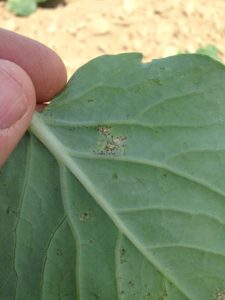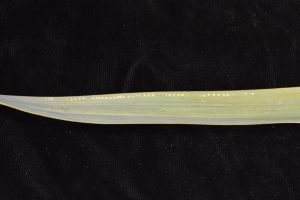Note: Today’s edition is the last regular IPM Update of the season. We will continue to monitor late season crop pests and will publish updates as necessary.
Sweet Corn
 Corn earworm (CEW) moth catches declined dramatically over this past week with evening temperatures dropping into the high 40s in many locations (see CEW blacklight map at left). In this map, areas in green roughly correspond to a 3-day schedule, while blue areas are in the 4-5 day range. Blue points within larger green areas should be considered “outliers”, and the broader color scheme in any particular region is more representative of the population. The current situation may change with somewhat warmer night temperatures forecast toward the end of the week. Should night temperatures begin to approach 60F or more, growers should consider treating remaining silks on a 3-4 rather than a 4-5 day schedule. Be aware that synthetic pyrethroids have become less effective at managing ear infestations from this pest over the past several years. For this reason, it is advisable to include products in the IRAC group 28 (Coragen, Besiege) or IRAC group 5 (Radiant, Entrust (OMRI approved)).
Corn earworm (CEW) moth catches declined dramatically over this past week with evening temperatures dropping into the high 40s in many locations (see CEW blacklight map at left). In this map, areas in green roughly correspond to a 3-day schedule, while blue areas are in the 4-5 day range. Blue points within larger green areas should be considered “outliers”, and the broader color scheme in any particular region is more representative of the population. The current situation may change with somewhat warmer night temperatures forecast toward the end of the week. Should night temperatures begin to approach 60F or more, growers should consider treating remaining silks on a 3-4 rather than a 4-5 day schedule. Be aware that synthetic pyrethroids have become less effective at managing ear infestations from this pest over the past several years. For this reason, it is advisable to include products in the IRAC group 28 (Coragen, Besiege) or IRAC group 5 (Radiant, Entrust (OMRI approved)).
The highest nightly CEW blacklight trap catches are as follows:
| Georgetown 5 | Farmingdale 2 | Chester 1 |
| New Egypt 5 | Allamuchy 1 | Centerton 1 |
| Crosswicks 3 | Beckett 1 | Eldora 1 |
| Matawan 3 | Belvidere 1 | Eldora 1 |
Southern NJ CEW pheromone trap catches also dropped significantly. This weeks’ map is generally in synch with the blacklight map in terms of schedules (see CEW pheromone map below at right). There are only a few remaining pheromone traps deployed at this time, and the result is much broader color bands on the pheromone map. Generally, the green portion of the map represents a 3-4 day schedule. The blue/white area on the Cumberland/Atlantic border is an outlier.
At present, the highest nightly pheromone trap catches are as follows: 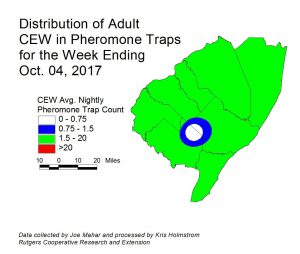
| Green Creek 6 |
| Berlin 1 |
| Pole Tavern 1 |
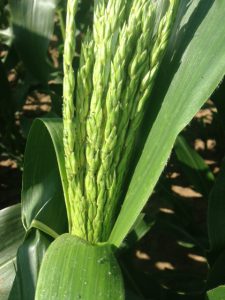 Many sweet corn plantings continue to harbor populations of the corn leaf aphid (see photo at left). These aphids are not adequately controlled by pyrethroid insecticides and if not managed properly, will end up on the ears. If these aphids are detected in tassels, it is advisable to target them specifically with the first 1-2 silk applications. Lannate has generally been good in the past, although acetamiprid (Assail) is also labeled for aphid management in sweet corn. Assail will not control caterpillar pests, and must be applied in addition to the preferred caterpillar material.
Many sweet corn plantings continue to harbor populations of the corn leaf aphid (see photo at left). These aphids are not adequately controlled by pyrethroid insecticides and if not managed properly, will end up on the ears. If these aphids are detected in tassels, it is advisable to target them specifically with the first 1-2 silk applications. Lannate has generally been good in the past, although acetamiprid (Assail) is also labeled for aphid management in sweet corn. Assail will not control caterpillar pests, and must be applied in addition to the preferred caterpillar material.
Silking Spray Schedules*:
South – 3 days
Central – 3 days
North – 4-5 days
*These recommendations are based on regional catches. Adhere to tighter spray schedules if indicated by local trap catches.
Pepper Weevil Update
Monitoring for pepper weevil has largely ended, though one farm in the Glassboro area continues to battle the weevil. Concerns have been raised about using pepper waste from processors on fields, especially since adult weevils were trapped near the areas where the waste had been spread.
Pumpkins and Winter Squash
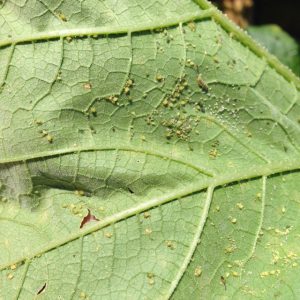 This is the time of year when melon aphid populations continue to appear in more pumpkin and winter squash fields. These aphids can build to extremely high levels in fields (see photo at left), resulting in sticky droppings accumulating on the surface of maturing fruit. If they are discovered in more than two sites in a 10 site sample, consider an application specifically to manage them. Useful materials include Fulfill and Assail, but a full list of recommended products may be found in the Pumpkin and Winter squash section Commercial Vegetable Recommendations. As fruit mature and vines begin to collapse, the need to manage aphids declines as foliage is not above the fruit.
This is the time of year when melon aphid populations continue to appear in more pumpkin and winter squash fields. These aphids can build to extremely high levels in fields (see photo at left), resulting in sticky droppings accumulating on the surface of maturing fruit. If they are discovered in more than two sites in a 10 site sample, consider an application specifically to manage them. Useful materials include Fulfill and Assail, but a full list of recommended products may be found in the Pumpkin and Winter squash section Commercial Vegetable Recommendations. As fruit mature and vines begin to collapse, the need to manage aphids declines as foliage is not above the fruit.
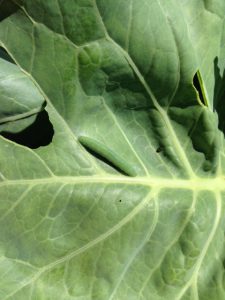 Late summer cole crop plantings are experiencing infestations, primarily from imported cabbageworm (ICW) (photo at left) and diamondback moth (DBM) larvae (photo at lower right). While both are damaging to these crops, DBM is more difficult to manage, as it is quite resistant to synthetic pyrethroid insecticides. DBM is effectively managed (along with all other caterpillar pests) with insecticides in the IRAC class 5 (Radiant, Entrust (OMRI approved)), and class 28 (Coragen, Exirel). DBM larvae are very small and are tapered toward both ends. They thrash violently when disturbed. ICW larvae grow larger and have a covering of velvety hairs as they grow. Check 5 consecutive plants each in 10 random sites within the planting. Consider treating if 10% or more
Late summer cole crop plantings are experiencing infestations, primarily from imported cabbageworm (ICW) (photo at left) and diamondback moth (DBM) larvae (photo at lower right). While both are damaging to these crops, DBM is more difficult to manage, as it is quite resistant to synthetic pyrethroid insecticides. DBM is effectively managed (along with all other caterpillar pests) with insecticides in the IRAC class 5 (Radiant, Entrust (OMRI approved)), and class 28 (Coragen, Exirel). DBM larvae are very small and are tapered toward both ends. They thrash violently when disturbed. ICW larvae grow larger and have a covering of velvety hairs as they grow. Check 5 consecutive plants each in 10 random sites within the planting. Consider treating if 10% or more 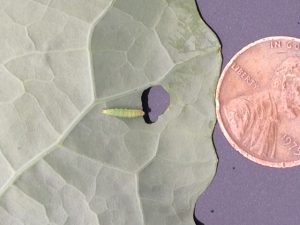 leafy cole crops are infested at any stage, or in heading types in the 0-9 true leaf stage. In heading types from 9 leaf to early head, a level of 20% plants infested may be acceptable. As heads form, the threshold should drop to 5% plants infested with any larvae, to protect the marketable portion of the plant.
leafy cole crops are infested at any stage, or in heading types in the 0-9 true leaf stage. In heading types from 9 leaf to early head, a level of 20% plants infested may be acceptable. As heads form, the threshold should drop to 5% plants infested with any larvae, to protect the marketable portion of the plant.
 Cabbage aphid (see photo at left) has been appearing in some cole crop plantings over the past week. This typically late season pest may be managed effectively with conventional aphid insecticides but is easy to miss due to its’ tendency to inhabit protected areas such as the heavily folded areas of kales and the sprout portion of Brussels sprouts. It is important to remove one sprout per 5 plant sample while looking for caterpillar pests. The sprout should be stripped of its’ outer leaves to see if there are cabbage aphids there. These whitish, dusty-looking aphids can make sprouts unmarketable, as they become a contaminant. Do not wait for a large population to develop, but consider treating if cabbage aphids are found in more than one site. For insecticides useful at managing cabbage aphid, see the Cole Crop section in the 2016-17 Commercial Recommendations Guide.
Cabbage aphid (see photo at left) has been appearing in some cole crop plantings over the past week. This typically late season pest may be managed effectively with conventional aphid insecticides but is easy to miss due to its’ tendency to inhabit protected areas such as the heavily folded areas of kales and the sprout portion of Brussels sprouts. It is important to remove one sprout per 5 plant sample while looking for caterpillar pests. The sprout should be stripped of its’ outer leaves to see if there are cabbage aphids there. These whitish, dusty-looking aphids can make sprouts unmarketable, as they become a contaminant. Do not wait for a large population to develop, but consider treating if cabbage aphids are found in more than one site. For insecticides useful at managing cabbage aphid, see the Cole Crop section in the 2016-17 Commercial Recommendations Guide.
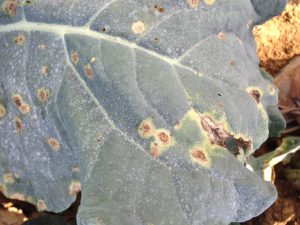 Alternaria, a fungal infection of cole crops, is active on many plantings at this time. Alternaria infections typically occur on mature foliage, resulting in target shaped lesions (see photo at left). In serious cases (as can happen when crops like broccoli are double-cropped in a season), alternaria can destroy enough foliage to impact head size and qualitiy. Proper rotation is a must as well because the fungus will persist on undecomposed host debris. For a complete listing of recommended fungicides for alternaria, see the Cole Crop section in the 2016-17 Commercial Recommendations Guide.
Alternaria, a fungal infection of cole crops, is active on many plantings at this time. Alternaria infections typically occur on mature foliage, resulting in target shaped lesions (see photo at left). In serious cases (as can happen when crops like broccoli are double-cropped in a season), alternaria can destroy enough foliage to impact head size and qualitiy. Proper rotation is a must as well because the fungus will persist on undecomposed host debris. For a complete listing of recommended fungicides for alternaria, see the Cole Crop section in the 2016-17 Commercial Recommendations Guide.
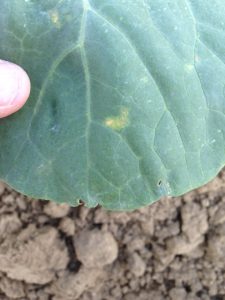 Crucifer downy mildew is also showing up now. It primarily infects broccoli, collards and kohlrabi, but can impact all cole crops. It causes small yellow lesions on the upper leaf surface (photo at left) on the lower surface, these lesions produce fine, whitish sporulation (photo at right). If you pass your cursor over the image, you may be able to increase the size enough to see the spore producing structures. For a complete listing of recommended fungicides for crucifer downy mildew see the Cole Crop section in the 2016-17 Commercial Recommendations Guide.
Crucifer downy mildew is also showing up now. It primarily infects broccoli, collards and kohlrabi, but can impact all cole crops. It causes small yellow lesions on the upper leaf surface (photo at left) on the lower surface, these lesions produce fine, whitish sporulation (photo at right). If you pass your cursor over the image, you may be able to increase the size enough to see the spore producing structures. For a complete listing of recommended fungicides for crucifer downy mildew see the Cole Crop section in the 2016-17 Commercial Recommendations Guide.
Allium Leaf Miner
IPM personnel have again deployed allium leaf miner (ALM) traps in sites where they were in the spring. Checks of traps this week showed no ALM adults, but there were low numbers of leaves with egg/feeding scars on a chive planting in Mercer County (see photo of characteristic scars at left). Similar fields in Hunterdon and Morris counties did not have obvious signs of infestation, though injury is almost certainly occurring now. Growers of late season onions, scallions, and overwintering garlic and leeks should be alert to the possibility that sprays or barriers may be needed to manage infestations from this pest.
